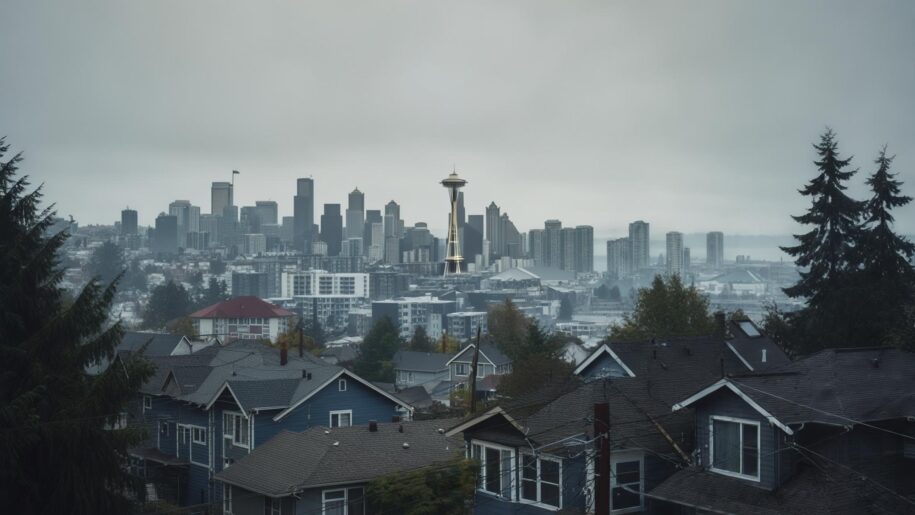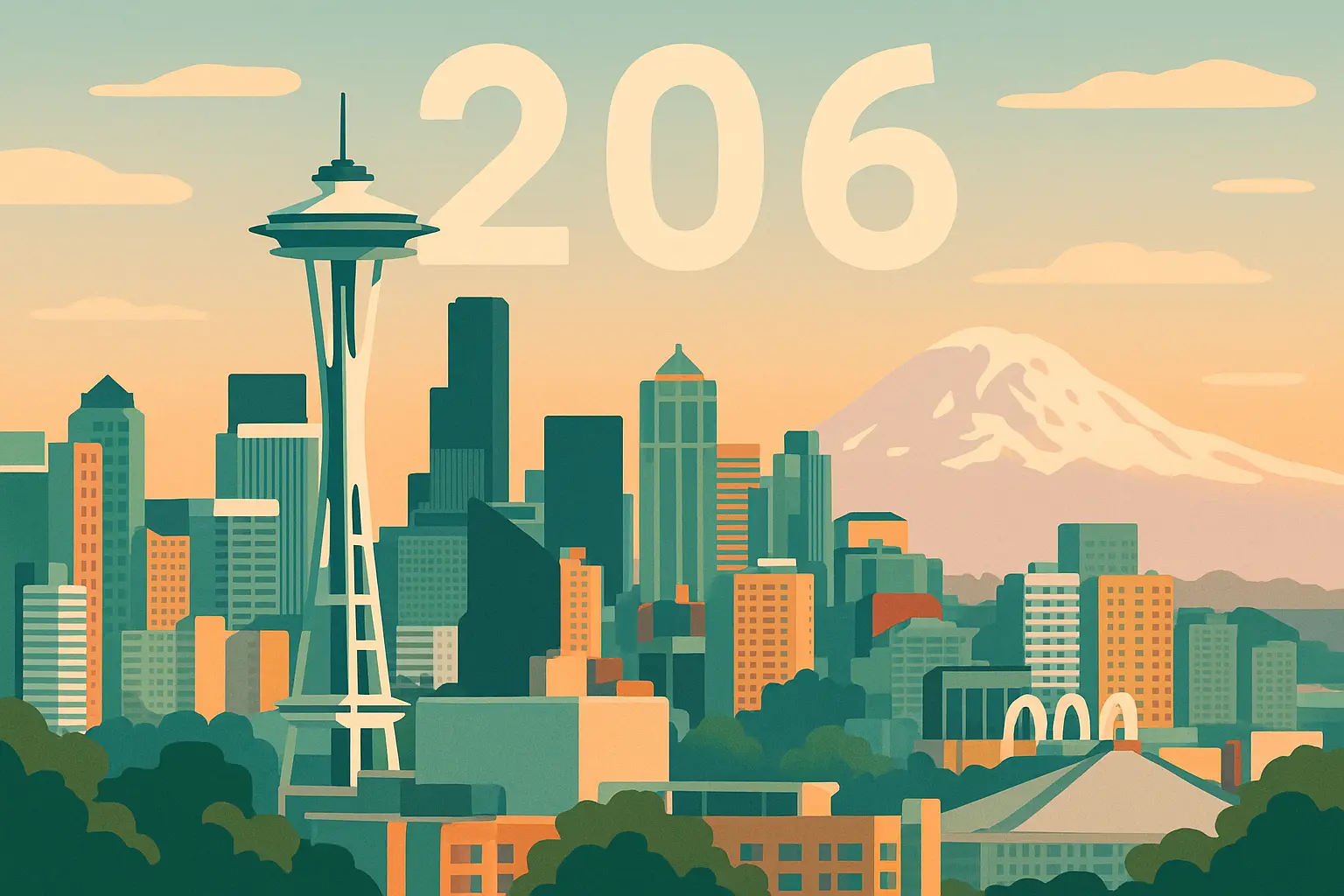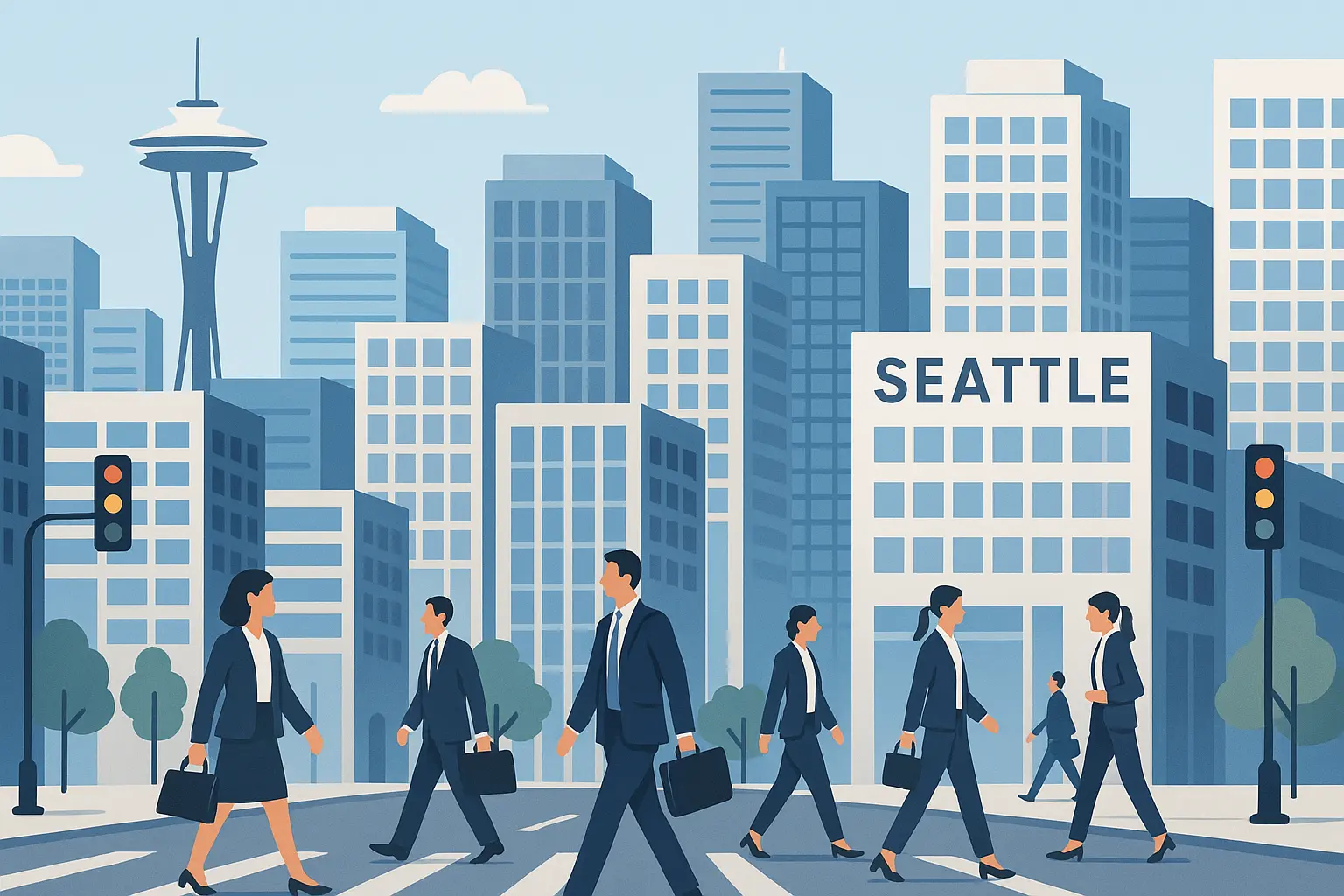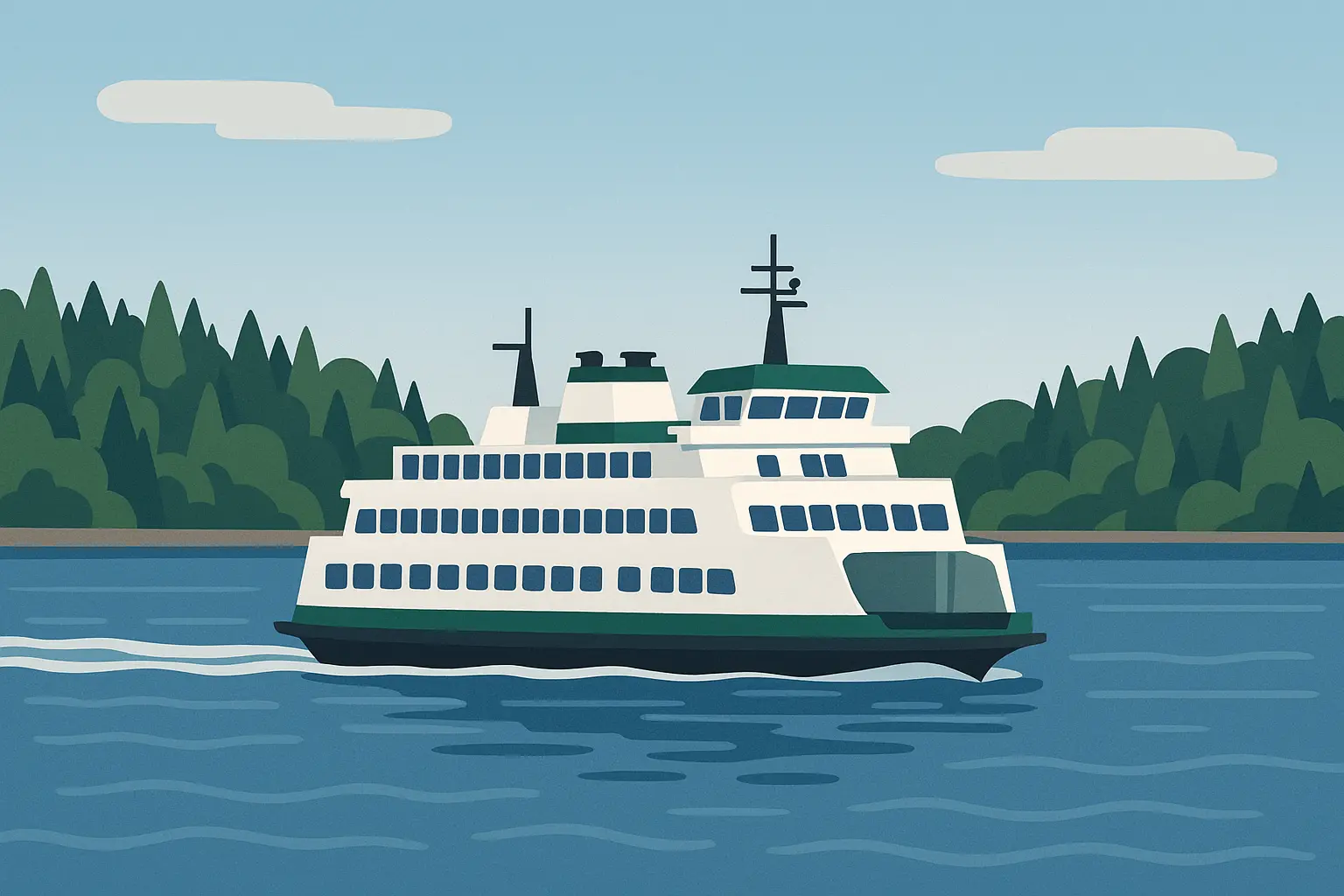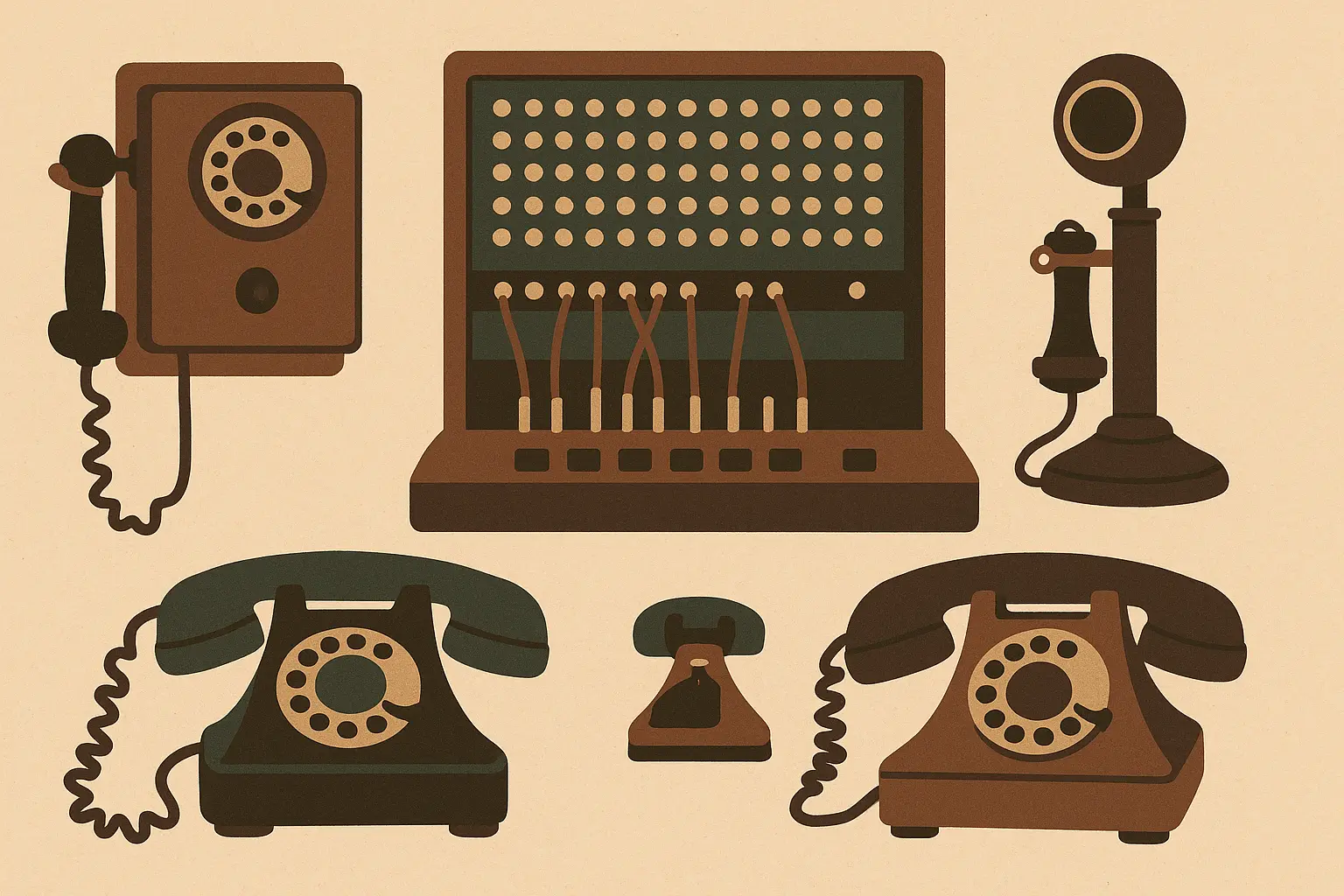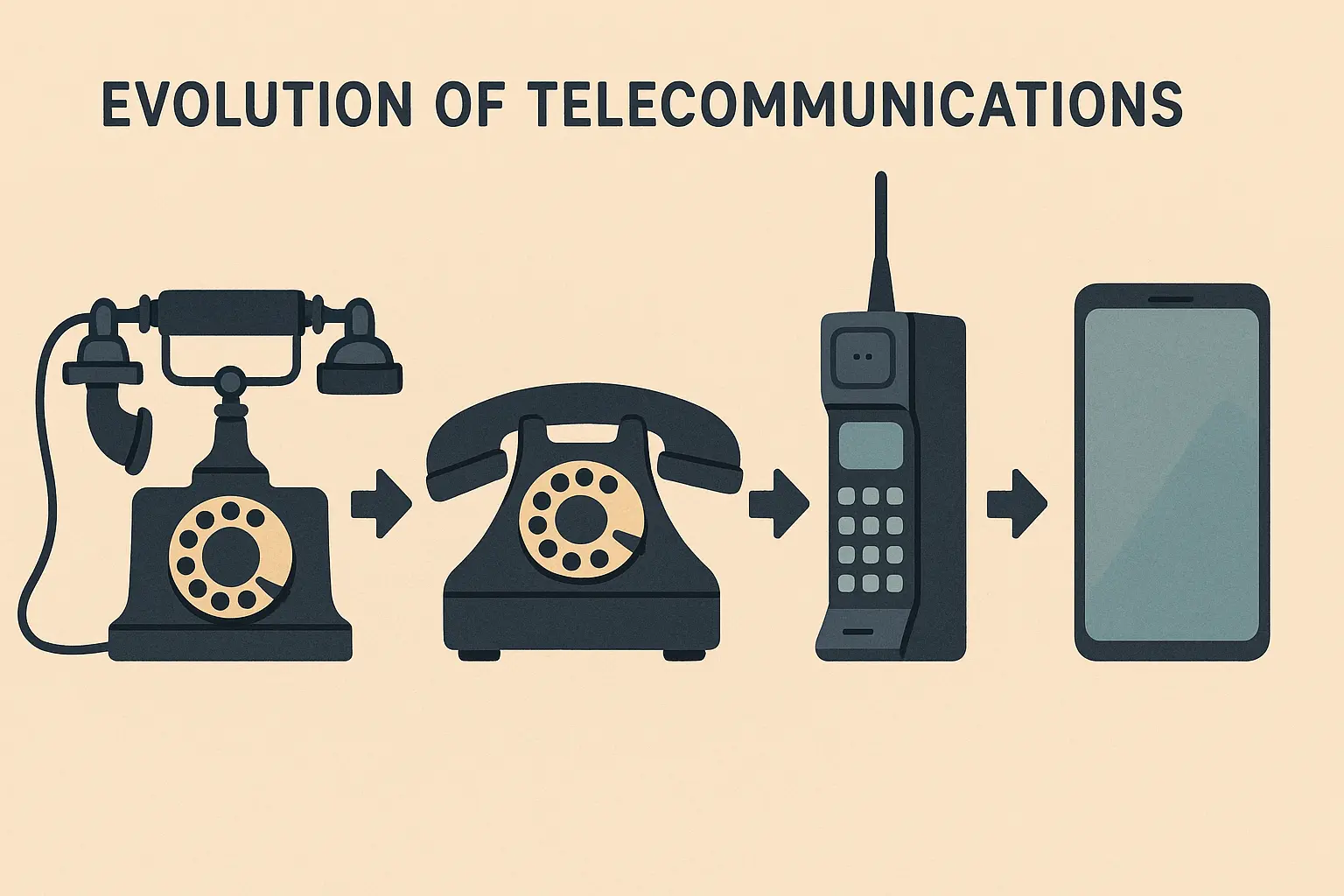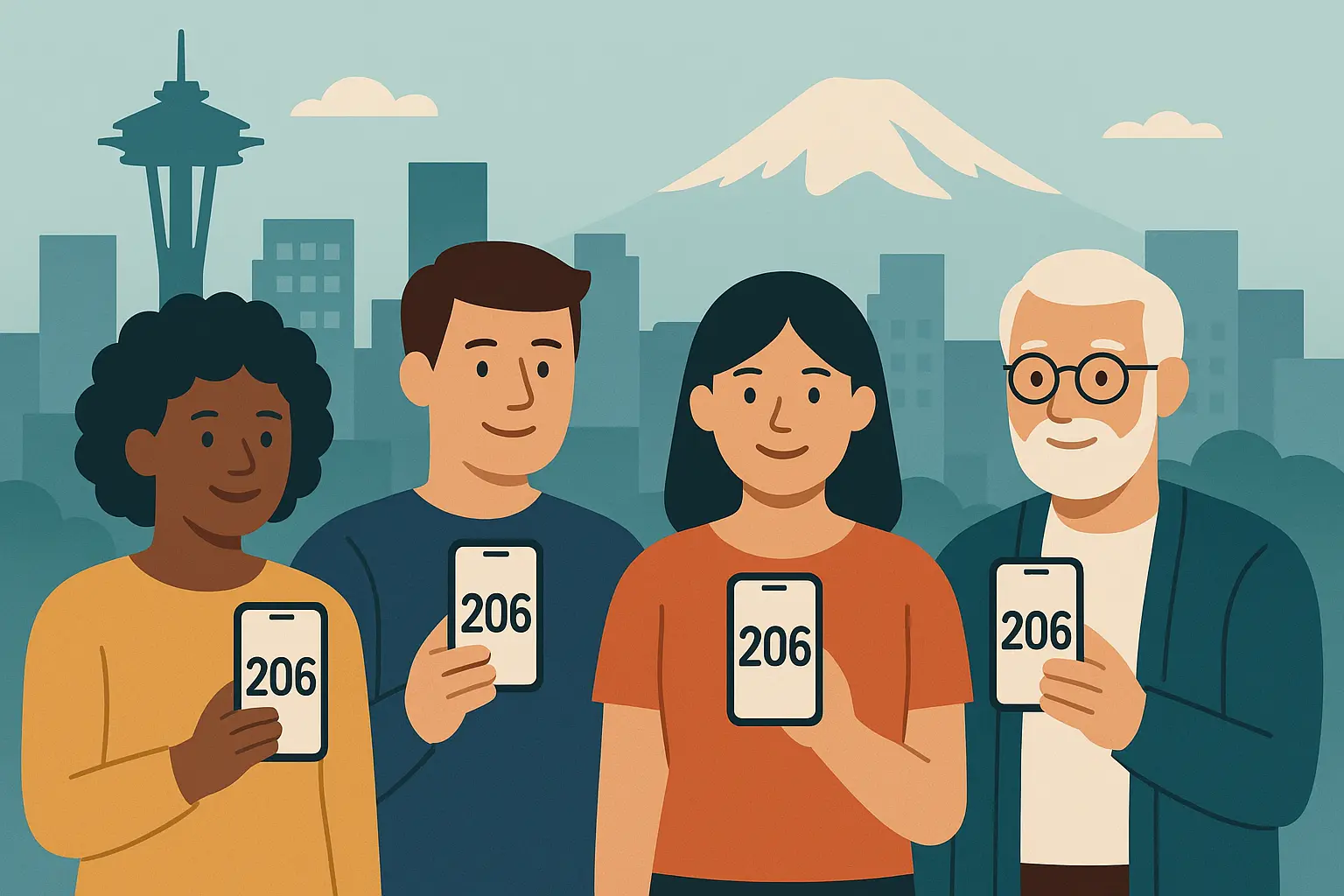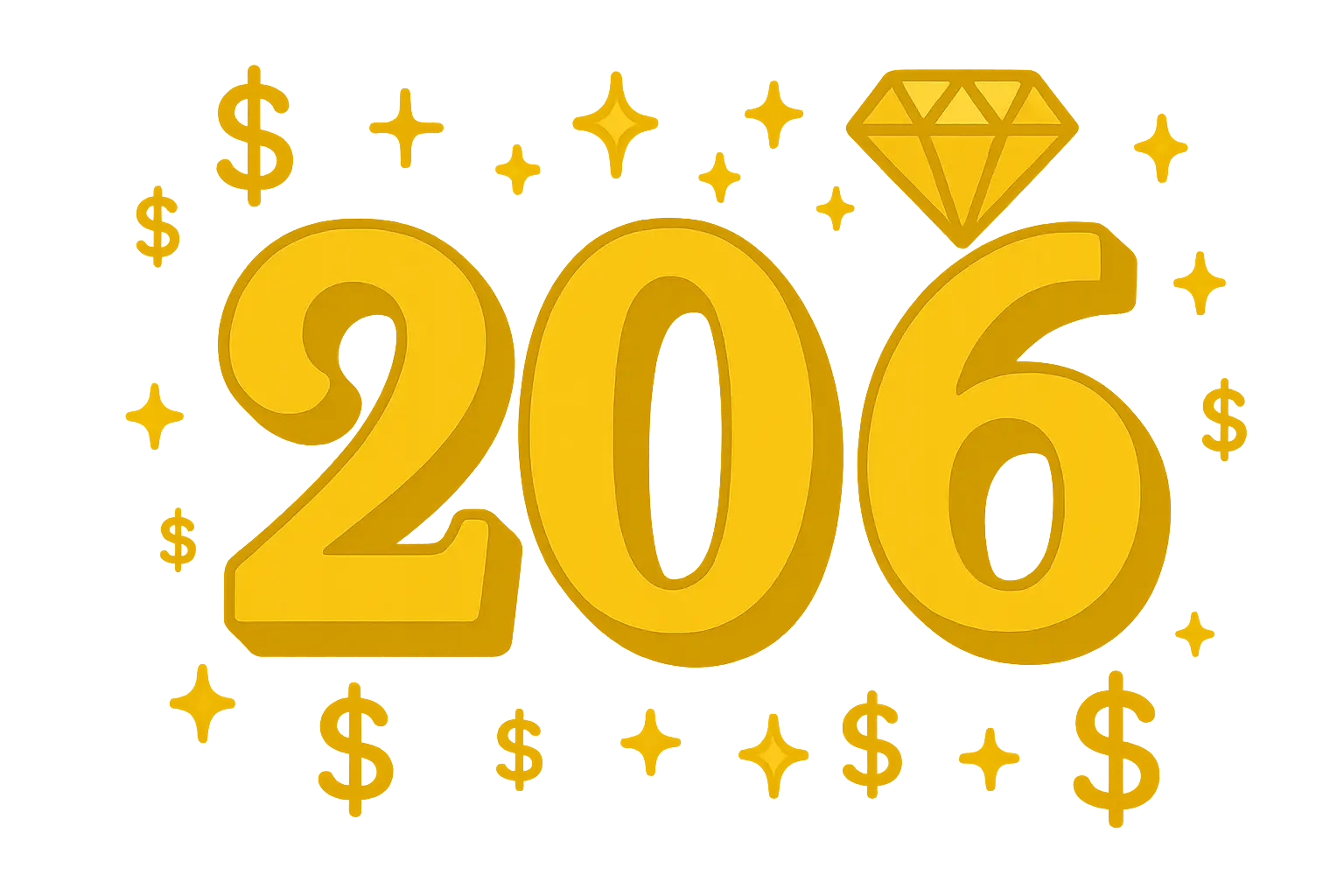My friend Jake moved to Seattle five years ago and still can’t get a 206 number. Every time he tries, he’s stuck with 564 or 425. Meanwhile, his neighbor who’s lived here since the ’90s guards her 206 like it’s a family heirloom. Here’s why Seattle’s original area code has become the city’s most exclusive status symbol.
The numbers tell a compelling story. According to ZipAtlas Area Code 206 Demographics, the total population of Area Code 206 is 1,297,232 people, making it one of the most densely populated phone regions in the Pacific Northwest. What started as Washington State’s only area code in 1947 has become something people fight to keep and pay premium prices to get.
Table of Contents
Table of Contents
-
Where 206 Actually Covers (It’s Not What You Think)
-
The Wild History Behind Seattle’s Original Area Code
-
Why Your 206 Number Is Technically Complex
-
Who’s Actually Using 206 Numbers Today
-
The Real Value of Owning a 206 Number
-
How Auto Forward SMS Protects Your Premium Number Investment
TL;DR
-
The 206 area code originally covered all of Washington State in 1947 but now serves only Seattle’s core metropolitan area
-
Geographic splits in 1957, 1995, and 1997 transformed 206 from a statewide identifier into an exclusive urban area code
-
The scarcity of new 206 numbers has created an informal market where memorable combinations command thousands of dollars
-
Businesses and long-time residents treat 206 numbers as valuable assets worth protecting and retaining
-
Auto Forward SMS helps protect your 206 number investment by ensuring you never miss critical messages
Where 206 Actually Covers (It’s Not What You Think)
Most people assume 206 encompasses all of greater Seattle, but the reality surprises even longtime residents. The coverage area has shrunk dramatically over the decades, concentrating into Seattle’s most economically significant neighborhoods and a couple of select communities.
So where exactly does 206 cover? The boundaries create an exclusive zone that includes downtown Seattle, iconic residential areas, and a handful of island communities that somehow kept their connection to the city’s premium numbering system.
Seattle’s Urban Core Gets the Premium Treatment
Downtown Seattle anchors the territory, housing the financial district, major corporate headquarters, and the commercial infrastructure driving the regional economy. This concentrated coverage represents the heart of the Pacific Northwest’s largest metropolitan region, including landmarks that define Seattle’s identity worldwide.
Here’s what actually gets the 206 treatment:
|
Geographic Area |
Population Coverage |
Key Features |
|---|---|---|
|
Downtown Seattle |
Business District Core |
Financial centers, corporate headquarters |
|
Capitol Hill |
Residential/Entertainment |
Nightlife, arts scene, diverse community |
|
Queen Anne |
Upscale Residential |
Near Space Needle, tech workers |
|
Magnolia |
Waterfront Community |
Discovery Park, affluent families |
|
West Seattle |
Island Community |
Beach access, ferry connections |
Downtown Seattle’s Business Powerhouse
The waterfront district and surrounding commercial zones form the economic engine for the entire Puget Sound region. Major corporations choose downtown addresses specifically to maintain their 206 numbers, viewing them as essential business assets that signal their commitment to the Seattle market.
The Neighborhoods That Define Seattle
Capitol Hill pulses with creative energy and diverse communities, while Queen Anne attracts tech professionals who want walkable access to downtown offices. These residential areas maintain distinct personalities while sharing the prestigious numbering system that connects them to Seattle’s broader identity.
A tech startup founder I know living in Capitol Hill maintains her 206 number as a badge of Seattle authenticity, using it on business cards and marketing materials to signal her deep connection to the local innovation ecosystem, even when traveling globally for investor meetings. Her number opens doors and starts conversations in ways that newer area codes simply cannot match.
Walk into any Capitol Hill coffee shop and you’ll overhear conversations about rent prices, the latest band playing at The Crocodile, and yes, people bragging about their 206 numbers. It’s become part of the neighborhood’s identity – a way to prove you belong to the “real” Seattle.
Industrial Areas That Keep Seattle Moving
The Port of Seattle and related shipping facilities handling international cargo operations fall within 206 coverage, supporting Seattle’s role as a major Pacific Rim trading hub. These industrial zones maintain the area code’s connection to the city’s working infrastructure, proving that 206 encompasses more than just trendy neighborhoods and corporate offices.
The Exclusive Island Communities
Beyond Seattle proper, two island communities share the 206 designation, creating a unique situation where you need a ferry to reach some of the most coveted phone numbers in the region.
Mercer Island’s Affluent Enclave
This wealthy suburban community on Lake Washington maintains 206 status despite its island location. Known for exceptional schools and property values that regularly break regional records, Mercer Island residents consider their area code alignment with Seattle proper as confirmation of their community’s premium status.
Vashon Island’s Rural Charm
Vashon Island is quirky – you need a ferry to get there, but somehow they kept their 206 numbers. It’s like having a rural address with a Manhattan zip code. Accessible only by ferry, Vashon Island represents the pastoral side of 206 territory while remaining connected to Seattle’s phone network. The island offers a unique blend of rural character and urban area code prestige that attracts artists, writers, and professionals seeking escape without sacrificing their connection to the city.
The Wild History Behind Seattle’s Original Area Code
Back in 1947, 206 covered the entire state of Washington. Imagine that – from the Canadian border down to Oregon, everyone had the same area code. This was back when the North American Numbering Plan launched, and Washington got one of the most geographically expansive numbering areas in the country.
When 206 Ruled the Entire State
During its statewide coverage period, 206 served sparse populations scattered across vast distances. Rural connectivity presented challenges that reflected the phone technology limitations of the mid-20th century, requiring creative solutions that seem primitive by today’s standards.
The Massive Territory Challenge
Picture coordinating phone service across mountain ranges, dense forests, and isolated farming communities using 1940s technology. The sparse population density across much of Washington made this arrangement work for decades, but growth around Puget Sound eventually demanded change.
Long-distance calls within the same area code often traveled hundreds of miles through multiple switching stations. A call from Seattle to Spokane was still “local” by area code standards, even though it crossed an entire state.
The Great Divide: How 206 Got Chopped Up
Population growth in Washington State, particularly around Puget Sound, forced the subdivision of the original 206 territory through a series of geographic splits and overlays. These changes were designed to accommodate increasing demand for phone numbers while preserving the area code’s core identity.
The evolution continues today. Beginning June 10, 2025, new phone numbers in the 206 area code region may be assigned the 564 area code as part of an ongoing overlay project according to MyNorthwest, marking another significant change in Seattle’s phone landscape. This 564 implementation represents the latest chapter in the ongoing story of Seattle’s numbering evolution.
For businesses managing multiple phone numbers across different regions, understanding US phone number format standards becomes crucial when coordinating communications between area codes like 206 and 564 assignments.
1957’s Eastern Washington Split
The creation of area code 509 in 1957 marked the first major division, separating Eastern Washington into its own numbering area. This split reflected the distinct geographic and economic differences between the state’s eastern and western regions, with the Columbia River serving as a natural boundary.
1995’s Suburban Exodus
Area code 360’s introduction in 1995 served outer Western Washington regions, beginning the process of concentrating 206 around Seattle’s metropolitan core. This change established the foundation for the area code’s current premium status by removing rural and suburban areas that diluted its urban identity.
1997’s Overlay Innovation
Rather than splitting 206 geographically, the 425 overlay system allowed existing numbers to remain unchanged while assigning new numbers in the same geographic area a different area code. This approach preserved the value of established 206 numbers while providing additional numbering capacity.
When Microsoft expanded its Redmond campus in the late 1990s, employees who had maintained their 206 numbers from Seattle residences kept them as status symbols, even though new hires received 425 numbers, creating an informal hierarchy based on area code seniority. The 206 became a badge of honor that distinguished longtime Seattle residents from recent arrivals.
From Utility to Premium Status
The transformation of 206 from a basic geographic identifier into one of the phone industry’s most coveted area codes reflects Seattle’s evolution into a major technology and business hub. The area code now represents urban sophistication and connection to the city’s thriving ecosystem, carrying cultural weight that extends far beyond simple phone utility.
Why Your 206 Number Is Technically Complex
Operating within the Pacific Time Zone significantly impacts business operations, emergency services coordination, and daily phone patterns for 206 users. The time zone specifications require careful attention to coordination with other regions, particularly for businesses serving national or international markets.
Time Zone Coordination Matters More Than You Think
During winter months, 206 operates at UTC-8, aligning with broader Pacific Coast business rhythms. This timing affects everything from customer service hours to automated system scheduling, requiring businesses to coordinate carefully with other time zones for effective communication and commerce.
The seasonal shift to Pacific Daylight Time (UTC-7) affects phone scheduling and coordination, particularly for businesses operating across multiple time zones or providing emergency services. I’ve seen companies struggle with this transition, especially when their phone systems aren’t properly configured for the time changes.
The Number Game: How It All Works
The people who manage phone numbers oversee the complex process of distributing and maintaining numbers within 206. They ensure adequate availability while preventing exhaustion of this premium numbering resource through smart management strategies that most people never see.
The economic significance of 206 is reflected in its demographics, with a median household income of $119,522, significantly higher than national averages, making these numbers particularly valuable to businesses targeting affluent customers. Source: ZipAtlas Area Code 206 Demographics. This wealth concentration makes 206 numbers especially attractive for luxury services, high-end retail, and professional services.
When setting up business communications, many companies need to understand international phone number formatting to ensure their 206 numbers work seamlessly with global clients and partners.
How Numbers Get Distributed
Three-digit codes following the area code identify specific switching facilities or geographic regions, helping route calls efficiently while maintaining the geographic integrity of the 206 system. These codes ensure optimal network performance and help phone providers manage traffic loads across different parts of the coverage area.
Keeping Your Number When You Switch
Federal regulations allow customers to maintain their 206 numbers when switching service providers, which has increased both the value and permanence of these numbers for businesses and individuals. This portability creates additional complexity in network management but provides crucial protection for number holders who view their 206 number as a valuable asset.
Here’s what you need to know about protecting your 206 number:
-
Verify number portability with new carriers before switching
-
Update account contact information regularly
-
Set up automatic payment to avoid service interruptions
-
Document your number ownership for business records
-
Consider backup forwarding services for critical communications
The 564 Overlay Mess
Here’s where it gets messy. In 2025, Seattle added the 564 area code as an “overlay.” Same geography, different numbers. Now you have to dial all 10 digits for every call, even to your neighbor. Old-timers hate it.
The addition marks the end of an era because 206 has been shorthand for Seattle — stitched into merch, social handles and civic identity — for decades according to Axios Seattle, highlighting the cultural significance of this phone change. The 564 implementation represents more than just technical necessity; it marks a cultural shift in how Seattle identifies itself through phone numbers.
Implementation Without Disruption
The overlay approach preserved the integrity and value of existing 206 numbers while expanding capacity. The careful rollout process was designed to minimize disruption to established users and businesses, though the transition still required significant adjustment from the community.
New Dialing Requirements
All calls within the region now require the area code plus seven-digit number, even for local calls. This represents a significant change in user behavior and phone practices that affects daily communication patterns, particularly for older residents who remember when local calls required only seven digits.
Who’s Actually Using 206 Numbers Today
Seattle’s major corporations and enterprises leverage 206 numbers for competitive advantage and market positioning. They recognize the area code’s association with the city’s innovative business environment and use it as a strategic asset that signals their commitment to the local market.
The professional landscape of the 206 region is impressive, with 69.8% of people in the labor force and an unemployment rate of just 5.0%, making it an attractive market for businesses seeking to establish credibility with a premium phone number. Source: ZipAtlas Area Code 206 Demographics. These employment statistics demonstrate the economic vitality that makes 206 numbers so valuable for business positioning.
Business World’s Premium Choice
Technology companies and startups prefer maintaining 206 numbers as a mark of Seattle authenticity. They view these numbers as essential for establishing credibility within the city’s competitive startup ecosystem and signaling their connection to the local innovation culture.
Similar to how businesses in other premium markets leverage their numbers for credibility, Seattle companies use San Francisco’s 415 area code as a model for understanding how geographic phone assets can enhance business positioning.
Walk into any Seattle coffee shop and you’ll overhear startup founders bragging about their 206 numbers. I know a guy who turned down a better phone plan because it meant giving up his 206. His reasoning? “Investors take me more seriously when they see I’m actually from Seattle, not some transplant with a 425 number.”
Here’s how different industries use 206 numbers:
|
Industry Sector |
206 Number Usage |
Business Advantage |
|---|---|---|
|
Technology Startups |
85% retention rate |
Local credibility marker |
|
Financial Services |
92% preference |
Trust and stability signal |
|
Healthcare |
78% adoption |
Community connection |
|
Legal Services |
89% maintenance |
Professional prestige |
|
Real Estate |
94% preference |
Local market expertise |
Tech Sector’s Authenticity Badge
Startups launching in Seattle’s competitive environment understand that a 206 number immediately communicates their local roots and commitment to the community. Venture capitalists and potential partners recognize this signal, often viewing it as evidence of the company’s understanding of the local market dynamics.
Financial Services Integration
Banks, investment firms, and financial technology companies use 206 numbers to signal their connection to Seattle’s growing fintech sector. The area code’s premium status enhances their market positioning and customer trust, particularly when competing against national firms that lack local phone presence.
Residents Guard Their Numbers Like Treasure
Long-time Seattle residents often protect their 206 numbers jealously, viewing them as badges of authenticity and connection to the city’s pre-boom character. Newcomers struggle to obtain these coveted phone assets, creating a clear divide between established residents and recent arrivals.
Number portability regulations have made it easier to keep 206 numbers when changing providers, but many residents still go to extraordinary lengths to ensure they don’t lose this valuable phone asset. They treat it as a form of digital real estate that appreciates over time.
Sarah Chen, a Seattle native who moved to Portland for work, maintains her 206 number and pays extra roaming charges rather than switch to a local Oregon number, using it as a conversation starter and proof of her Seattle roots when networking in the tech industry. Her number opens doors and starts conversations in ways that newer area codes simply cannot match.
For residents who travel frequently or relocate temporarily, learning how to forward text messages to email ensures they never miss important communications on their precious 206 numbers.
Retention at All Costs
People will switch apartments, change jobs, and even endure poor cellular service rather than give up their 206 numbers. I’ve witnessed friends pay significantly higher monthly fees to maintain their numbers with carriers that offer better coverage in their new neighborhoods, viewing the extra cost as insurance for their phone investment.
Social Status Symbol
In Seattle’s social and professional circles, having a 206 serves as an indicator of long-term residency and local authenticity. The cultural cache extends beyond mere phone utility, functioning as a form of social currency that carries weight in business networking and personal relationships.
The Premium Number Market
Want a 206 number that spells something cool? Good luck and bring your wallet. I’ve seen people pay $5,000 for a number that spells out their business name. One restaurant owner told me his 206 number that’s easy to remember brings in 30% more takeout orders than his old 425 number did.
As new 206 numbers become increasingly rare, informal markets have developed where businesses and individuals pay premium prices for particularly desirable number combinations. Vanity numbers with repeating digits or memorable sequences command thousands of dollars above standard phone rates, creating economic value that phone companies never anticipated when the system launched.
Real estate agents particularly covet numbers that spell out words related to their profession, while restaurants seek combinations that customers can easily remember for takeout orders. The 206 scarcity has transformed what was once a utility into a luxury commodity.
The Real Value of Owning a 206 Number
Look, it’s just three digits, but in Seattle, your area code tells a story. 206 means you were here before Amazon took over. Before the housing prices went crazy. Before everyone and their startup moved here. It’s like having an original piece of the city.
The 206 area code has evolved from a simple geographic identifier into a valuable phone asset that carries significant business, social, and economic implications for its holders. Understanding this value helps explain why people go to great lengths to obtain and retain these numbers, and why businesses view them as strategic investments in their Seattle market presence.
Premium number combinations within the 206 system command prices that would shock people unfamiliar with Seattle’s phone market. Businesses regularly pay five-figure premiums for memorable sequences, viewing them as marketing investments that pay dividends through improved customer recall and brand recognition.
Here’s what makes a 206 number valuable:
-
Assess memorability of number sequence
-
Evaluate business branding potential
-
Consider local market recognition value
-
Review competitor area code strategies
-
Calculate long-term retention benefits
Just as businesses in competitive markets understand the strategic value of premium numbers, Seattle companies recognize that maintaining Los Angeles with 310 area codes provides similar business advantages in their respective markets.
How Auto Forward SMS Protects Your Premium Number Investment
Since these numbers are so valuable, losing important texts because of bad cell service in Seattle’s hills is a nightmare. That’s where Auto Forward SMS comes in handy – it makes sure you never miss anything important on your precious 206 number.
Given the premium nature and scarcity of 206 numbers, protecting your investment becomes crucial. Auto Forward SMS provides essential backup and redundancy for your valuable 206 number by ensuring you never miss critical text messages, regardless of device failures, network issues, or Seattle’s challenging urban terrain that can interfere with cellular signals.
The app’s advanced filtering capabilities allow you to create specific forwarding rules for important business contacts or clients, while keyword filtering ensures only relevant communications trigger forwarding actions. For Seattle-based businesses that have invested in maintaining their 206 numbers as part of their market identity, Auto Forward SMS offers the reliability needed to ensure customer communications always reach the right people.
Whether you’re managing communications across multiple devices or need to forward text messages on Android to ensure business continuity, Auto Forward SMS provides the reliability your 206 number investment deserves. The 564 overlay implementation makes message management even more complex, requiring robust forwarding solutions that can handle multiple numbering systems seamlessly.
Ready to protect your 206 number investment? Download Auto Forward SMS today and ensure your premium Seattle number never lets you down when it matters most.
Final Thoughts
Seattle’s 206 area code went from covering an entire state to being the most exclusive three digits in the Pacific Northwest. Whether you inherited yours from the old days or you’re still hunting for one, it’s more than just a phone number – it’s a piece of Seattle history that fits in your pocket.
The 206 represents far more than just a three-digit prefix – it’s a piece of Seattle’s phone history and a valuable asset in today’s connected world. From its humble beginnings covering the entire state of Washington to its current status as one of America’s most coveted area codes, 206 has evolved alongside Seattle’s transformation into a major technology and business hub.
Whether you’re a long-time Seattle resident protecting your authentic 206 number or a business leveraging its premium status for market positioning, understanding the complexities and value of this area code helps you make informed decisions about your phone strategy. The technical specifications, geographic limitations, and cultural significance all contribute to making 206 numbers increasingly valuable in our digital age.
As Seattle continues to grow and evolve, 206 will likely become even more exclusive and valuable. Protecting your investment in this premium phone asset – whether through careful provider selection, number portability planning, or reliable message forwarding solutions – ensures you maintain your connection to Seattle’s prestigious phone legacy.
